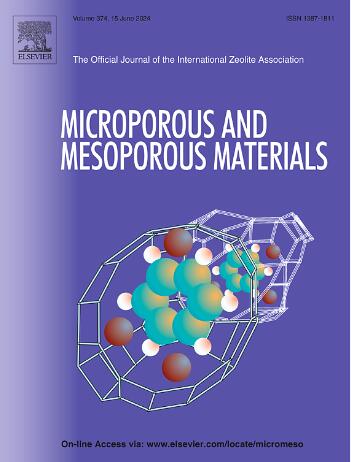一步法合成铝渣基苯胺吸附剂MIL-53(Al)
IF 4.8
3区 材料科学
Q1 CHEMISTRY, APPLIED
引用次数: 0
摘要
铝渣是铝在冶炼和回收过程中产生的工业废料,广泛应用于各行业;然而,它的应用是有限的。金属有机框架(mof)是由金属和有机类材料组成的下一代多孔材料,具有可调的性能,包括孔隙结构(形状和大小)、疏水性、亲水性和稳定性,使其适用于各种应用。本研究首次成功地以铝渣为原料一步合成了MIL-53(Al) MOF。渣滓衍生的MIL-53(Al)具有与常规MIL-53(Al)相似的高结晶度。苯胺是一种广泛应用于化学和制药工业但对人体健康和生态系统有害的化合物,它作为苯胺的吸附剂被进一步评价。液相吸附实验表明,渣滓衍生的MIL-53(Al)具有与常规MIL-53(Al)相似的吸附能力,这主要是由于其与苯胺的π -π和氢键相互作用。渣滓衍生的MIL-53(Al)的吸附等温线符合Langmuir模型,表明其对苯胺的主要吸附位点是微孔。此外,MIL-53(Al)在经过四次煅烧再生循环后仍保持其吸附能力。因此,本研究成功地以铝渣为前驱体合成了MIL-53(Al),并证明了其作为水净化剂的潜在有效性。本文章由计算机程序翻译,如有差异,请以英文原文为准。

One-step synthesis of aluminum dross-derived MIL-53(Al) as an aniline adsorbent
Aluminum dross, an industrial waste product generated during the smelting and recycling of aluminum, is used in various industries; however, its application is limited. Metal–organic frameworks (MOFs), next-generation porous materials comprising metals and organic likers, offer tunable properties, including pore structure (shape and size), hydrophobicity, hydrophilicity, and stability, making them versatile for various applications. This study successfully achieved the one-step synthesis of MIL-53(Al), an MOF, using aluminum dross as a starting material for the first time. The dross-derived MIL-53(Al) exhibited high crystallinity, similar to that of conventional MIL-53(Al). It was further evaluated as an adsorbent for aniline, a compound widely used in chemical and pharmaceutical industries but harmful to human health and ecosystems. Liquid-phase adsorption experiments demonstrated that dross-derived MIL-53(Al) achieved an adsorption capacity similar to that of conventional MIL-53(Al), primarily owing to π‒π and hydrogen bonding interactions with aniline. The adsorption isotherm of dross-derived MIL-53(Al) conformed to the Langmuir model, indicating that the primary adsorption sites for aniline were its micropores. Furthermore, this MIL-53(Al) retained its adsorption capacity after up to four regeneration cycles using calcination. Thus, this study successfully synthesized MIL-53(Al) using aluminum dross as a precursor and demonstrated its potential effectiveness as a water purification agent.
求助全文
通过发布文献求助,成功后即可免费获取论文全文。
去求助
来源期刊

Microporous and Mesoporous Materials
化学-材料科学:综合
CiteScore
10.70
自引率
5.80%
发文量
649
审稿时长
26 days
期刊介绍:
Microporous and Mesoporous Materials covers novel and significant aspects of porous solids classified as either microporous (pore size up to 2 nm) or mesoporous (pore size 2 to 50 nm). The porosity should have a specific impact on the material properties or application. Typical examples are zeolites and zeolite-like materials, pillared materials, clathrasils and clathrates, carbon molecular sieves, ordered mesoporous materials, organic/inorganic porous hybrid materials, or porous metal oxides. Both natural and synthetic porous materials are within the scope of the journal.
Topics which are particularly of interest include:
All aspects of natural microporous and mesoporous solids
The synthesis of crystalline or amorphous porous materials
The physico-chemical characterization of microporous and mesoporous solids, especially spectroscopic and microscopic
The modification of microporous and mesoporous solids, for example by ion exchange or solid-state reactions
All topics related to diffusion of mobile species in the pores of microporous and mesoporous materials
Adsorption (and other separation techniques) using microporous or mesoporous adsorbents
Catalysis by microporous and mesoporous materials
Host/guest interactions
Theoretical chemistry and modelling of host/guest interactions
All topics related to the application of microporous and mesoporous materials in industrial catalysis, separation technology, environmental protection, electrochemistry, membranes, sensors, optical devices, etc.
 求助内容:
求助内容: 应助结果提醒方式:
应助结果提醒方式:


